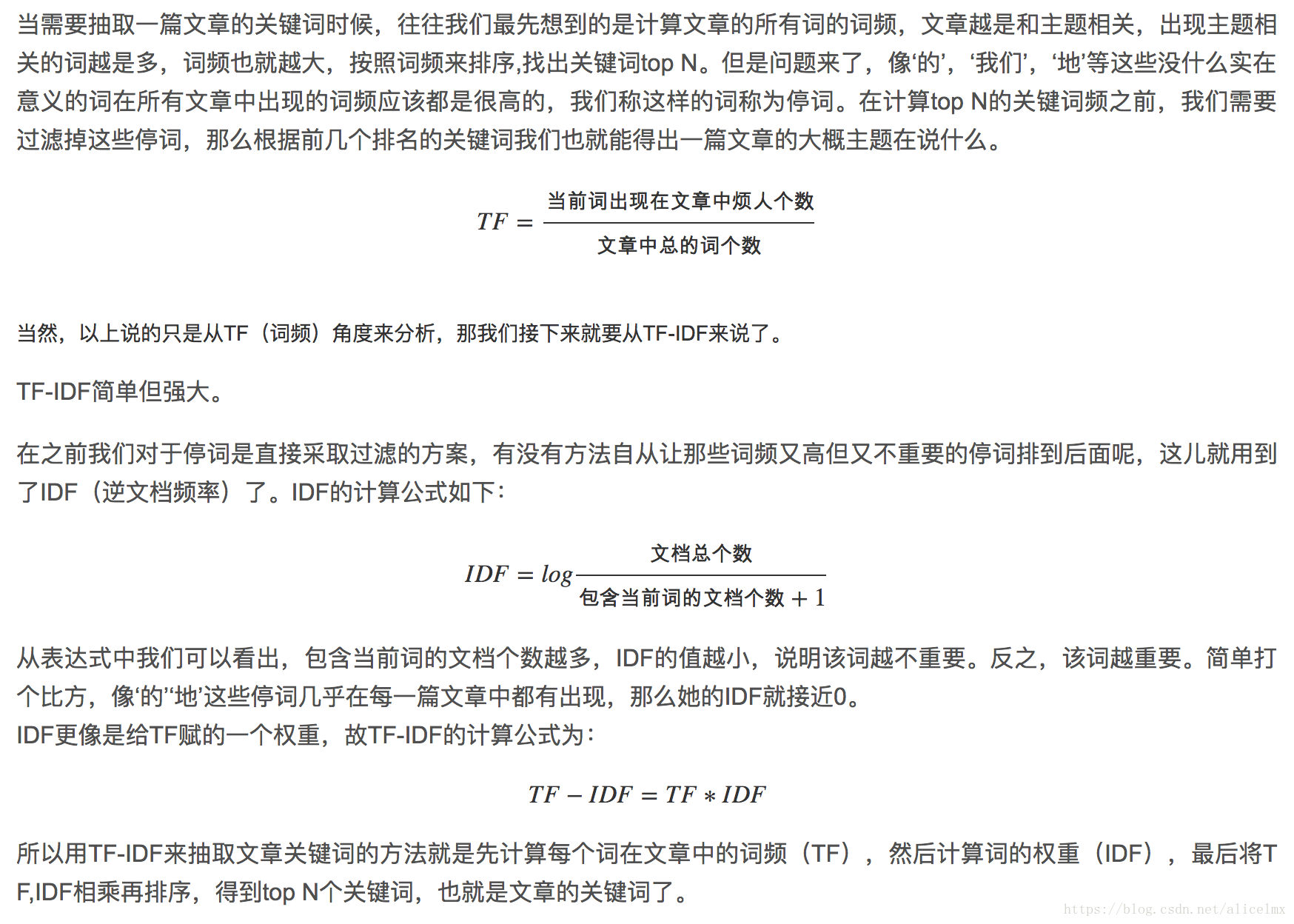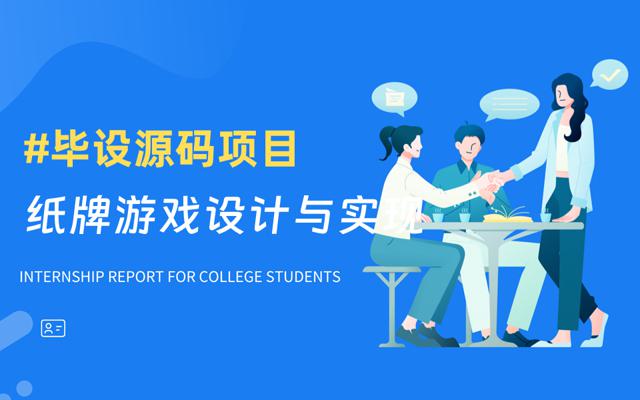1.基本流程
1. 1、准备好数据食材、去停用词并利用 结巴 (jieba)进行分词处理
数据食材选用参考: NLP中必不可少的语料资源
jieba分词模块参考 官方文档 啦~ ```python
本程序用于将搜狗语料库中的文本进行分词,并且去除停用词
coding=utf-8
import jieba import jieba.posseg as pseg import time import os ''' 训练集:1200 测试集:200 '''
文本分词
def cutText(dirname): # dirname数据目录 for category in os.listdir(dirname): catdir = os.path.join(dirname,category) if not os.path.isdir(catdir): continue files = os.listdir(catdir)
i = 0
for cur_file in files:
print("正在处理"+category+"中的第"+str(i)+"个文件.............")
filename = os.path.join(catdir,cur_file)
#读取文本
with open(filename,"r",encoding='utf-8') as f:
content = f.read()
#进行分词
words = pseg.cut(content)
# 用于剔除停用词的列表
finalContent = []
# 停用词列表
stopWords = [line.strip() for line in open('Chinesestopword.txt', 'r', encoding='utf-8').readlines()]
for word in words:
word = str(word.word)
# 如果该单词非空格、换行符、不在听用词表中就将其添加进入最终分词列表中
if len(word) > 1 and word != '\n' and word != '\u3000' and word not in stopWords:
finalContent.append(word)
# 组合成最终需要的字符串
finalStr = " ".join(finalContent)
# 写入文件
writeFileName = writeFilePathPrefix+"/"+category+"/"+str(i)+".txt"
print(writeFileName)
with open(writeFileName,"w",encoding = 'utf-8') as f:
f.write(finalStr)
i = i + 1
print("成功处理"+category+"中的第"+str(i)+"个文件~哦耶!")
if name == ' main ': # 记录开始时间 t1=time.time()
readFilePathPrefix = "SogouData/ClassFile"
writeFilePathPrefix = "SogouDataCut"
cutText(readFilePathPrefix)
# 记录结束时间
t2=time.time()
#反馈结果
print("您的分词终于完成,耗时:"+str(t2-t1)+"秒。")
```
1. 2、利用 卡方检验 特征选择
卡方检验: 在构建每个类别的词向量后,对每一类的每一个单词进行其卡方统计值的计算。 1. 首先对卡方 检验所需的 a、b、c、d 进行计算。 a 为在这个分类下包含这个词的文档数量; b 为不在该分类下包含这个词的文档数量; c 为在这个分类下不包含这个词的文档数量; d 为不在该分类下,且不包含这个词的文档数量。 2. 然后得到该类中该词的卡方统计值 公式为 float(pow((a d - b c), 2)) /float((a+c) * (a+b) * (b+d) * (c+d))。 3. 对每一类别的所有词按卡方值进行排序,取前 k 个作为该类的特征值,这里我们取 k 为 1000 ```python
使用开方检验选择特征
按UTF-8编码格式读取文件
import codecs import math import sys
ClassCode = [ '财经','房产','股票','家居','科技','时政','娱乐' ]
构建每个类别的词Set
分词后的文件路径
textCutBasePath = "SogouDataCut/"
构建每个类别的词向量
def buildItemSets(classDocCount): termDic = dict()
# 每个类别下的文档集合用list<set>表示, 每个set表示一个文档,整体用一个dict表示
termClassDic = dict()
for eachclass in ClassCode:
currClassPath = textCutBasePath+eachclass+"/"
eachClassWordSets = set()
eachClassWordList = list()
for i in range(classDocCount):
eachDocPath = currClassPath+str(i)+".txt"
eachFileObj = open(eachDocPath, 'r')
eachFileContent = eachFileObj.read()
eachFileWords = eachFileContent.split(" ")
eachFileSet = set()
for eachword in eachFileWords:
stripEachWord = eachword.strip(" ")
if len(stripEachWord) > 0:
eachFileSet.add(eachword)
eachClassWordSets.add(eachword)
eachClassWordList.append(eachFileSet)
termDic[eachclass] = eachClassWordSets
termClassDic[eachclass] = eachClassWordList
return termDic, termClassDic
对得到的两个词典进行计算,可以得到a b c d 值
K为每个类别选取的特征个数
卡方计算公式
def ChiCalc(a, b, c, d): result = float(pow((a d - b c), 2)) /float((a+c) * (a+b) * (b+d) * (c+d)) return result
def featureSelection(termDic, termClassDic, K):
termCountDic = dict()
for key in termDic:
# C000008
classWordSets = termDic[key]
# print(classWordSets)
classTermCountDic = dict()
for eachword in classWordSets: # 对某个类别下的每一个单词的 a b c d 进行计算
# 对卡方检验所需的 a b c d 进行计算
# a:在这个分类下包含这个词的文档数量
# b:不在该分类下包含这个词的文档数量
# c:在这个分类下不包含这个词的文档数量
# d:不在该分类下,且不包含这个词的文档数量
a = 0
b = 0
c = 0
d = 0
for eachclass in termClassDic:
# C000008
if eachclass == key: #在这个类别下进行处理
for eachdocset in termClassDic[eachclass]:
if eachword in eachdocset:
a = a + 1
else:
c = c + 1
else: # 不在这个类别下进行处理
for eachdocset in termClassDic[eachclass]:
if eachword in eachdocset:
b = b + 1
else:
d = d + 1
eachwordcount = ChiCalc(a, b, c, d)
classTermCountDic[eachword] = eachwordcount
# 对生成的计数进行排序选择前K个
# 这个排序后返回的是元组的列表
sortedClassTermCountDic = sorted(classTermCountDic.items(), key=lambda d:d[1], reverse=True)
count = 0
subDic = dict()
for i in range(K):
subDic[sortedClassTermCountDic[i][0]] = sortedClassTermCountDic[i][1]
termCountDic[key] = subDic
return termCountDic
def writeFeatureToFile(termCountDic , fileName): featureSet = set() for key in termCountDic: for eachkey in termCountDic[key]: featureSet.add(eachkey)
count = 1
file = open(fileName, 'w')
for feature in featureSet:
# 判断feature 不为空
stripfeature = feature.strip(" ")
if len(stripfeature) > 0 and feature != " " :
file.write(str(count)+" " +feature+"\n")
count = count + 1
print(feature)
file.close()
if name == ' main ': # 调用buildItemSets # buildItemSets形参表示每个类别的文档数目,在这里训练模型时每个类别取前200个文件 termDic, termClassDic = buildItemSets(1200) termCountDic = featureSelection(termDic, termClassDic, 1000) writeFeatureToFile(termCountDic, "SVMFeature.txt")
```
1. 3、利用 TF IDF算法*进行特征权重计算
TF-IDF算法 :
- 全称叫 Term Frequency-Inverse Document Frequency 词频-逆文档频率算法
- 主要用于关键词抽取
- 优点:每个词的权重与特征项在文档中出现的频率成正比,与在整个语料中出现该特征项的文档数成反比。
-
原理解说:
 训练文本的特征向量表示数据在 train.svm文件中,测试文本的特征向量表示数据在test.svm 中。
训练文本的特征向量表示数据在 train.svm文件中,测试文本的特征向量表示数据在test.svm 中。
```python
import FeatureSelecion
import math import sys
采用TF-IDF 算法对选取得到的特征进行计算权重
documentCount = 200 # 每个类别选取200篇文档
ClassCode = [ '财经','房产','股票','家居','科技','时政','娱乐' ]
构建每个类别的词Set
分词后的文件路径
textCutBasePath = "SogouDataCut/"
def readFeature(featureName): featureFile = open(featureName, 'r') featureContent = featureFile.read().split('\n') featureFile.close() feature = list() for eachfeature in featureContent: eachfeature = eachfeature.split(" ") if (len(eachfeature)==2): feature.append(eachfeature[1]) # print(feature) return feature
读取所有类别的训练样本到字典中,每个文档是一个list
def readFileToList(textCutBasePath, ClassCode, documentCount): dic = dict() for eachclass in ClassCode: currClassPath = textCutBasePath + eachclass + "/" eachclasslist = list() for i in range(documentCount): eachfile = open(currClassPath+str(i)+".txt") eachfilecontent = eachfile.read() eachfilewords = eachfilecontent.split(" ") eachclasslist.append(eachfilewords) # print(eachfilewords) dic[eachclass] = eachclasslist return dic
计算特征的逆文档频率
def featureIDF(dic, feature, dffilename): dffile = open(dffilename, "w") dffile.close() dffile = open(dffilename, "a")
totalDocCount = 0
idffeature = dict()
dffeature = dict()
for eachfeature in feature:
docFeature = 0
for key in dic:
totalDocCount = totalDocCount + len(dic[key])
classfiles = dic[key]
for eachfile in classfiles:
if eachfeature in eachfile:
docFeature = docFeature + 1
# 计算特征的逆文档频率
featurevalue = math.log(float(totalDocCount)/(docFeature+1))
dffeature[eachfeature] = docFeature
# 写入文件,特征的文档频率
dffile.write(eachfeature + " " + str(docFeature)+"\n")
# print(eachfeature+" "+str(docFeature))
idffeature[eachfeature] = featurevalue
dffile.close()
return idffeature
计算Feature's TF-IDF 值
def TFIDFCal(feature, dic,idffeature,filename): file = open(filename, 'w') file.close() file = open(filename, 'a') for key in dic: classFiles = dic[key] # 谨记字典的键是无序的 classid = ClassCode.index(key)
for eachfile in classFiles:
# 对每个文件进行特征向量转化
file.write(str(classid)+" ")
for i in range(len(feature)):
if feature[i] in eachfile:
currentfeature = feature[i]
featurecount = eachfile.count(feature[i])
tf = float(featurecount)/(len(eachfile))
# 计算逆文档频率
featurevalue = idffeature[currentfeature]*tf
file.write(str(i+1)+":"+str(featurevalue) + " ")
file.write("\n")
if name == ' main ': dic = readFileToList(textCutBasePath, ClassCode, documentCount) feature = readFeature("SVMFeature.txt") # print(len(feature)) idffeature = featureIDF(dic, feature, "dffeature.txt") TFIDFCal(feature, dic,idffeature, "train.svm")
```
1. 4、基于训练文本的特征向量数据,使用 LIBSVM库 训练SVM 模型
使用libsvm对train.svm进行模型训练,和对test.svm模型进行预测
测试命令:
```sh 对train.svm文件数据进行缩放到[0,1]区间 ./svm-scale -l 0 -u 1 train.svm > trainscale.svm
对test.svm文件数据进行缩放到[0,1]区间 ./svm-scale -l 0 -u 1 test.svm > testscale.svm
对trainscale.svm 文件进行模型训练 ./svm-train -s 1 trainscale.svm trainscale.model
对testscale.svm 文件进行模型预测,得到预测结果,控制台会输出正确率 ./svm-predict testscale.svm trainscale.model testscale.result ```
1. 5、对于测试集进行特征向量表示,代入训练得到的 SVM 模型中进行预测分类
预测结果:92%

目前这个阶段,能够讲到这个程度,以后在补充吧,小明酱撤退了~
参考文献
- 一种面向文本分类的机器学习平台的设计与实现(北京邮电大学·赵江山)
- 中文文本自动校对系统设计与实现(西南交通大学·张涛)
- 基于Spring Boot的多用户博客系统的设计研究(青海师范大学·罗涛)
- 基于网络用户行为分析的用户推荐反馈系统的设计(北京化工大学·石钊)
- 文本分析资源与任务管理系统的设计与实现(北京交通大学·宋奕文)
- 一种面向文本分类的机器学习平台的设计与实现(北京邮电大学·赵江山)
- 网络新闻分类系统及个性化新闻网站的研究与应用(内蒙古工业大学·王继明)
- 中文文本自动校对系统设计与实现(西南交通大学·张涛)
- 基于Spring Boot的多用户博客系统的设计研究(青海师范大学·罗涛)
- Text Classification Based on Graph Convolutional Neural Network with Intimacy Matrix and Text Linking(华中师范大学·夏冰)
- 基于网络爬虫的信息采集分类系统设计与实现(厦门大学·周茜)
- 基于商品名称的电商平台商品自动分类的研究与实现(西南交通大学·黄超)
- 财经领域事件抽取技术的研究与应用(北京理工大学·陈贺)
- 网站运营分析系统设计与实现(电子科技大学·蒋黎)
- 基于Python的非结构化数据检索系统的设计与实现(南京邮电大学·董海兰)
本文内容包括但不限于文字、数据、图表及超链接等)均来源于该信息及资料的相关主题。发布者:毕业设计客栈 ,原文地址:https://m.bishedaima.com/yuanma/35680.html











